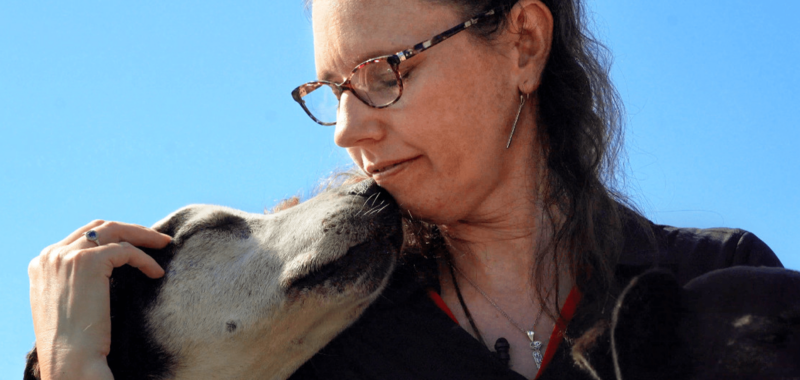For Cornell University geneticist Heather Huson, soccer and softball games weren’t on the family calendar growing up. Her family raced sled dogs instead. What started slowly as a casual hobby evolved into her mother, step-father, and sister all competing in races. The family competed during the winter months in their home state of Pennsylvania, owned upwards of 50 dogs, and found community.
“We had kind of like a whole extra family that were sled dog mushers that we would see every weekend in the winter,” Huson tells Popular Science. Huson continued to race, eventually competed in the International Federation of Sleddog Sports World Championships, and won the Tok Race of Champions in 2004. This six-dog race, still held in Tok, Alaska remains Huson’s favorite event.
Now retired from racing, Huson has her eyes on a physically smaller prize with a greater impact–understanding sled dog genetics.

What makes a sled dog?
Huson is studying the genetic differences between Siberian huskies that are bred for sledding, showing, or as a pet, in addition to the varied genetic lineages in sled dogs, and what makes them such incredible canine athletes.
“When we say ‘sled dogs,’ most of the public think of Siberian huskies or Alaskan malamutes,” explains Huson. “And yes, these are sled dogs. They were created for that, but they’ve also been molded into kind of these purebred dogs as well. They’re faster and they’re just more competitive.”
Surprisingly, almost any type of dog breed can technically become a sled dog. Even standard poodles have successfully completed the Iditarod. There is also no true definition of what an Alaskan sled dog is, other than can it perform in a race. Sled dogs are primarily still mixed breeds and that genetic mixing helps give them the traits that they need to make it through racing.

According to Huson, sled dogs generally have an “amazing worth ethic” and they almost always want to run. Thousands of years of breeding have led to these animal athletes that can withstand cold temperatures and run over various distances.
Huson experienced this canine athleticism when she first took to the trail as a musher at only seven-years-old. Taking these athletic dogs outside and exercising with them–to her, the ultimate way to feel that human-dog bond–was exhilarating.
“It was a real sense of accomplishment to train them and then see how well they did,” says Huson. “For better or worse, it taught me those responsibilities of how these are animals, you darn well, better take care of them. It was really just that human-dog bond on steroids.”
The breed for speed. Or not?
Racing dogs are similar to humans, in that there is a difference between a three mile run and a 26.2 mile marathon. The shortest races that a dog will compete in is three miles and these short distances offer mushers and breeders more flexibility.
“There’s a significant difference between dogs that have been selected for distance racing or sprint racing,” says Huson. “Especially in the sprint racing, there’s a lot more crosses with pointers, German short hair pointers, English pointers, salukis, greyhounds. This is where you really want more speed and you have more flexibility on something like their hair coat.”
[ Related: How different is Balto, the heroic sled dog, from today’s Siberian huskies? ]
For dogs racing thousands of miles like those that run the Iditarod, mushers can’t be as flexible since they need dog breeds with good hair and durability in their feet to make it over the snow and harsh terrain.
According to Huson, the attempts to breed for speed is particularly interesting from a genetics perspective. There have been some attempts at breeding greyhounds–who can run over 40 miles per hour–into sled dogs.
“It makes sense why you would do that. But when I did the genetics of it, I never found traces of greyhounds in the general sled dog population.”

Traits from these sleek race dogs would completely disappear over time. By comparison, if pointers are bred in, those traits will stay.
“With both my perspective as a dog musher as well as the geneticist, I think the real reason is that the greyhounds just don’t have any endurance, where the pointers do,” says Huson. “The greyhounds have got nothing to get them on the three miles.”
[ Related: Humans have partnered with sled dogs for 9,500 years. ]
Talking dogs
Huson is now continuing her research at Cornell University, where she hopes to learn more about how genes are related to the biology and evolution of dogs and other animals. Her work has particularly strong applications in understanding aging, and it can be applied to better testing, breeding, and health management in dogs. Huson also feels like she has the perfect pedigree for helping both the four and two-legged members of the sled dog community.

“I believe sled dog mushers are more accepting and trusting of my research because I do know sled dogs. I can ‘talk dogs’ with them and totally understand what they are saying and they understand what I’m saying,” says Huson. “They see I am genuine and want to understand and help. Hence, they also come to me when they have a genetic question. I miss racing a lot but stay in touch with the sport and people through my research.”


